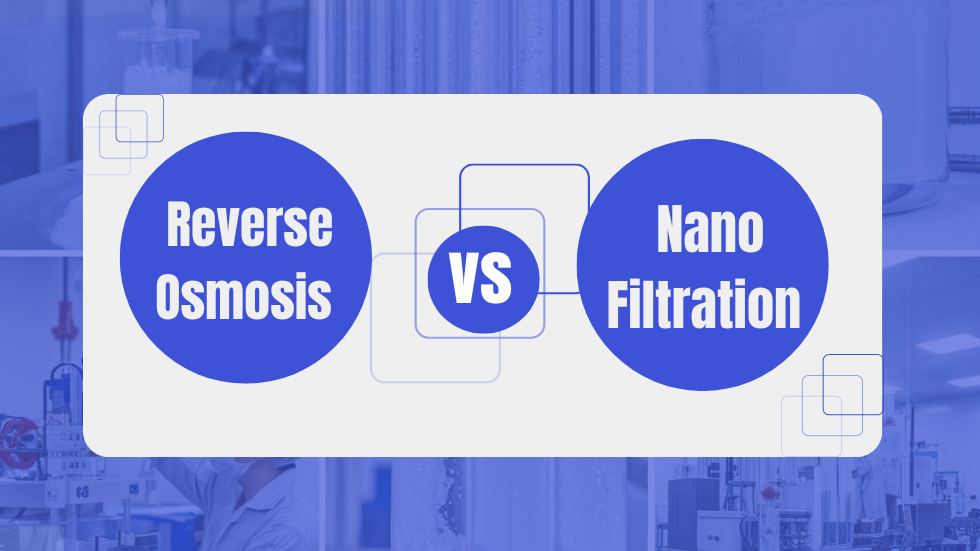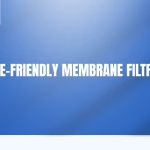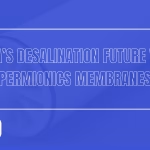Introduction
In the field of water treatment, Reverse osmosis and nanofiltration are regarded as the two most commonly applied technologies. Both of these processes have the same functionality of using a membrane to filter water and remove impurities. However, there are some variations between these two methods as well. Through this article, we will present the differences categorically.
1. Reverse Osmosis (RO)
- Process Overview
In this process, water is passed through a semi-permeable membrane, and pressure is applied on the side of the membrane, which is in the opposite direction of the natural osmosis. Through this process, some water is collected after passing through the membrane, which is called permeate. Other than this, some amount of water is rejected by the membrane, which is known as concentrate.
- Advantages of Reverse Osmosis
There are various advantages of RO among which high efficiency is one of the main advantages. The pore size of the RO membrane usually ranges from 0.0001 to 0.001 microns. Through this, even the smallest impurities can be extracted from the water. That means this process allows the removal of impurities which include dissolved salts, viruses, and bacteria.
- Challenges of Reverse Osmosis
Although RO has many benefits, it has some disadvantages as well. The high level of filtration of RO is quite expensive. Apart from this, RO systems also need high pressure so that the water can pass through a semi-permeable membrane. The process is comparatively inefficient and also has a low recovery rate of only 30-50%. This indicates that for every 100 gallons of water entering the system, only 30 to 50 gallons are treate,d which means that the rest will be discharged as concentrate.
2. Nanofiltration (NF)
- Process Overview
Nanofiltration is considered a similar process having slightly different characteristics. This process uses a membrane that has slightly larger pores, which range from 0.001 to 0.01 microns.
- Advantages of Nanofiltration
Nanofiltration does not require high pressure like RO and also has a higher recovery rate, which makes it better than reverse osmosis. It has a 50 to 70% recovery rate and can also help to get rid of different contaminants like dissolved salts, viruses, and bacteria.
- Challenges of Nanofiltration
This process has a bigger pore size of membrane compared to RO, which is why the process is not as efficient and effective as RO while removing very small impurities.
3. Key Differences Between Reverse Osmosis and Nanofiltration
- Comparison between Reverse Osmosis and Nanofiltration
Feature/Application | Reverse Osmosis | Nanofiltration |
| Removal of impurities | This removes water pollutants like dissolved salts and other small molecules. It also can extract the smallest impurities. | Larger molecules can be removed through this process which includes organic compounds and proteins. This also partially reduces dissolved salts from water. |
| Efficiency | Has higher efficiency due to the smaller size of pores in the membrane. | Has moderate efficiency as the pore size is bigger than RO |
| Pore size | Ranges between 0.0001 to 0.001 microns. | Ranges between 0.001 to 0.01 microns. |
| Application | The smaller pore size allows this system to be applied in the drinking water production sector as well as the pharmaceutical sector due to the requirement of pure water. | It is more suitable and commonly used for treating wastewater or other industrial applications, as these sectors need a high recovery of water. |
| Cost | More expensive due to the higher pressure requirement. | Less expensive than RO. NF systems have lower installation charges as wel,l making it more convenient. |
| Flexibility | Less flexible as it has a lower recovery rate. | More flexible as it has a higher recovery rate and can also be used with a wider range of feedwater quality. Also works in high turbidity and organic matter. |
4. Reducing Operational Costs with Permionics’ Water Treatment Technologies
Both RO and NF systems can be utilized together to have lower maintenance costs and higher efficiency levels. Permionics is a pioneer company in Liquid Separation and Membrane Technology. The organization uses both RO and nanofiltration systems, along with other filtration technologies. This ensures that clients are getting customized wastewater management processes and high-purity water solutions effectively. Through this, industries can enjoy financial advantages as high-performance water treatment systems allow them to boost their return on investment.
5. Conclusion
RO and NF systems have some similarities but also have some core differences regarding the type of impurities that they can reduce. It is also seen that although RO has higher efficiency,it is less efficient compared to NF systems. NF provides better efficiency in a lower budget, which makes it more flexible as well. Permionics is a leading company that utilizes both RO and NF technologies and other filtration methods to provide customized water treatment solutions to various industries.






